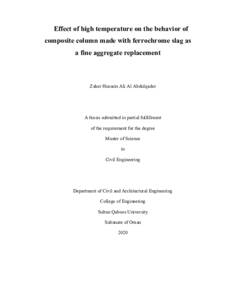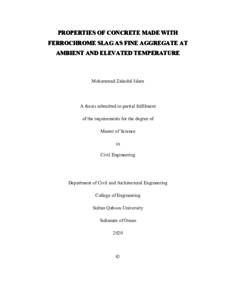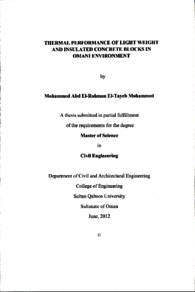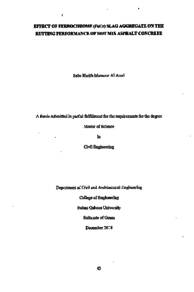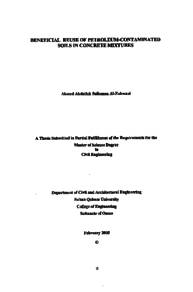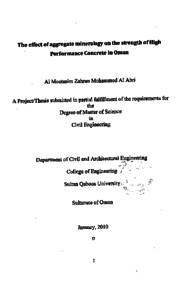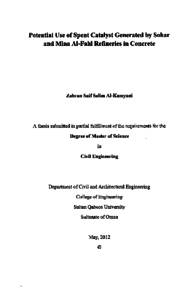Document
Effect of high temperature on the behavior of composite column made with ferrochrome slag as a fine aggregate replacement.
Publisher
Sultan Qaboos University.
Gregorian
2020
Language
English
Subject
English abstract
Over the last few decades, the composite structural system in high-rise buildings is widely
used and concrete-filled steel tubular (CFST) column is part of this system as well as there
is great effort to use alternative materials to produce concrete in order to enhance the
mechanical properties, reduce environmental impact and saving cost and resources.
Meanwhile, composite columns exposure to fire can lead to a serious structural
deterioration and possible failure of columns. Therefore, this thesis presents a study on
the behavior and mechanical properties of CFST stub columns with three different
concrete mixes using conventional fine aggregate, 50% and 100% ferrochrome slag (FCS)
as a fine aggregate replacement at ambient and elevated temperatures (200°C, 400°C,
600°C and 800°C). The literature review highlights that there is no research conducted to
investigate the behavior of CFST columns made with FCS as a fine aggregate at ambient
and elevated temperatures. The results show that the ultimate strength of CFST stub
columns enhances at ambient and almost all elevated temperatures, the compressive
stiffness and ductility of CFST stub columns are higher compared with the conventional
CFST stub columns at ambient temperature. The EC4 and ACI codes show a conservative
prediction of the value of ultimate strength for the CFST stub columns at ambient
temperature compared to the experimental results for the three concrete mixes and this is
supportive by other researches. Furthermore, the ultimate strength and compressive
stiffness of CFST stub columns that contains 50% to 100% of FCS in the concrete mix is
better than a conventional CFST stub column at ambient temperature. Meanwhile, the
residual ultimate strength and compressive stiffness are higher compared with the
conventional CFST stub columns at almost all elevated temperatures. Therefore, FCS is
a good replacement to conventional fine aggregate in the concrete mix of CFST stub
columns.
Member of
Resource URL
Arabic abstract
على مدى العقود القليلة الماضية، يتم استخدام النظام الهيكلي المركب في المباني الشاهقة على نطاق واسع ويعتبر العمود الأنبوبي الفولاذي المملوء بالخرسانة (CFST) جزءًا من هذا النظام بالإضافة إلى بذل جهد كبير لاستخدام مواد بديلة لإنتاج الخرسانة من أجل تحسين الخواص الميكانيكية وتقليل التأثير البيئي وتوفير التكاليف والموارد. وفي الوقت نفسه، يمكن أن يؤدي تعرض الأعمدة المركبة للحريق إلى تدهور هيكلي خطير وإمكانية فشل الأعمدة. لذلك، تقدم هذه الرسالة دراسة عن السلوك والخصائص الميكانيكية للأعمدة الصغيرة من (CFST) مع ثلاث خلطات خرسانية مختلفة باستخدام الركام الناعم التقليدي، ?? ? و??? ? من الخبث الفيرو-كروم كبديل للركام الناعم في درجات الحرارة المحيطة والارتفاع (??? درجة مئوية، ??? درجة مئوية، ??? درجة مئوية و??? درجة مئوية). تسلط مراجعة الأدبيات الضوء على أنه لا يوجد بحث تم إجراؤه للتحقيق في سلوك أعمدة (CFST) المصنوعة من خبث الفيرو-كروم كركام ناعم في درجات الحرارة المحيطة والمرتفعة. أظهرت النتائج أن القوة النهائية للأعمدة الصغيرة من (CFST) تعزز في البيئة المحيطة وتقريبا جميع درجات الحرارة المرتفعة، الصلابة وضغط ليونة للأعمدة الصغيرة من (CFST) أعلى مقارنة مع للأعمدة الصغيرة من (CFST) التقليدية في درجة الحرارة المحيطة. يظهر الكود الأوروبي الرابع ومعهد الخرسانة الأمريكية تنبؤًا متحفظًا بقيمة القوة النهائية للأعمدة الصغيرة من (CFST) عند درجة الحرارة المحيطة مقارنة بالنتائج التجريبية لخلطات الخرسانة الثلاثة. علاوة على ذلك، فإن استخدام خبث الفيرو-كروم بنسبة ??? ? في مزيج الخرسانة للأعمدة الصغيرة من (CFST) له قوة نهائية أفضل وصلابة ضغط مقارنة مع الأعمدة الصغيرة من (CFST) التقليدية في درجة الحرارة المحيطة. وفي الوقت نفسه، تكون القوة النهائية المتبقية والصلابة الانضغاطية أعلى مقارنة للأعمدة الصغيرة من (CFST) التقليدية في جميع درجات الحرارة المرتفعة تقريبًا. لذلك، يعد خبث الفيرو-كروم بديلاً جيدًا للركام الناعم التقليدي في خليط الخرسانة للأعمدة الصغيرة من (CFST).
Category
Theses and Dissertations

